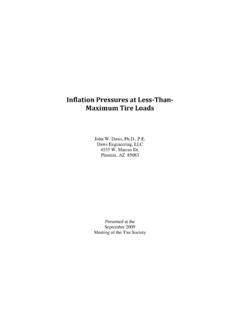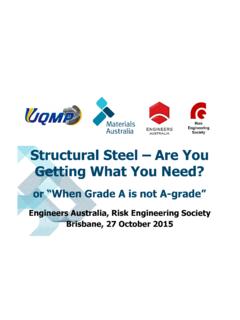Transcription of Fractography of Tire Tread Separations - Daws Engineering
1 Paper No. 67. Fractography of Tire Tread Separations By: J. W. Daws, , *. Exponent Failure Analysis Associates Phoenix, AZ. Presented at a meeting of the Rubber Division, American Chemical Society San Francisco, CA. April 28-30, 2003. *Speaker Fractography OF TIRE Tread . separation . John W. Daws, , Sr. Managing Engineer, Exponent Failure Analysis Associates 1850 W. Pinnacle Peak Rd., Phoenix, AZ 85027. ABSTRACT. In-service catastrophic radial tire failure is often a separation of the Tread and outer steel belt from the tire casing and inner steel belt. These Separations generally occur in the field at high temperature and high speed. In this study, tire belt-leaving-belt failures were created on a flat-track machine at high speed. The actual Separations were captured on high-speed video to locate the origin of the belt-leaving-belt failure.
2 Surfaces corresponding to the gradual cracking of the skim rubber along the edges of the belts, initiation of a belt-leaving-belt separation , high-speed tearing, and termination of the separation were described. The resulting fracture surfaces were then compared with surfaces found on tires that had failed in field service. INTRODUCTION. Tire failure analysis is usually focused on the mechanism of the separation of the outer steel belt from the tire casing and inner steel belt. The analyst must determine the point of origin of the separation from the appearance of the fracture surfaces. Smith1 described the microscopy of tire Tread pieces gathered from roadsides in Arizona, California, and New Mexico. However, it is often the case in actual forensic investigation that the tire Tread pieces are not recovered, leaving the analyst to deal with examining the inner steel belt's exposed outer surface.
3 This situation makes an understanding of the tire casing fracture surface important. In field Tread separation events, the fracture surfaces can often be confounded by pre-tear polishing, post- separation skidding, and impact damage. The objective of this paper is to document the appearance of the outer skim surface of the inner steel belt resulting from a Tread separation . Reference samples were created by cutting tires along the shoulders between the two steel belts and monitoring the tearing progression and belt-leaving-belt separation on a flat track machine at high speed and temperature. The resulting fracture surface starting and ending points were documented based on high-speed video data. The various fracture surfaces produced were then compared to surfaces from tires that had experienced a Tread separation in actual use.
4 EXPERIMENTAL. The tires used in this study were all P235/75R15 passenger car tires of the same construction. A number of tires were cut circumferentially about both shoulders to a depth of approximately 50 mm between the two steel belts that make up the crown reinforcement of the tire. The Tread was then cut parallel to the wires of the outer steel belt in one location to generate a weak spot for the initiation of the belt-leaving-belt separation . This method of creating a belt- leaving-belt separation on demand was outlined by Fay et for use in vehicle testing. Each tire was mounted in order to simulate a right side tire on a vehicle, assuming that the serial side of the tire would normally be mounted facing in. Each tire was inflated to bar and loaded to 6670 N. Each tire was then accelerated on a flat track machine to a speed of 112 km/hour in 10 seconds [s].
5 And run at that speed until the Tread and outer steel belt separated from the tire casing. The belt-leaving-belt separation event was recorded on digital high- speed video at 1000 frames/s in order to capture the point of initiation of the separation as well as the direction of propagation. separation initiation, separation propagation direction, and separation termination were all captured. The fracture surfaces on the outer skim of the casing inner steel belt from the resulting Tread Separations were examined and photographed. Fracture surfaces found on the inner skim surface of the Tread and outer steel belt were obviously corresponding images of the tire casing surfaces. These tire casing fracture surfaces were compared to corresponding fracture surfaces from tires that had experienced field failures.
6 In this study, the radial direction was taken to lie along the body ply cords of the casing. The circumferential direction was taken to lie perpendicular to the radial direction, also in the plane of the casing. All photographs are oriented so that the circumferential direction is horizontal and the radial direction is vertical. Also, for all photos, the serial side of the tire is at the bottom of the photograph and the opposite serial side is at the top. OBSERVATIONS AND DISCUSSION. GENERAL FLAT TRACK TEST OBSERVATIONS. During the course of the testing on the flat track machine, the resulting Tread Separations exhibited several consistent characteristics. First, the tire casing never lost pressure during the separation event. In general, the belt- leaving-belt Separations occurred in less than 30 s for these tearing tests.
7 The separated Tread and outer steel belt pieces were always hot to the touch, and in some cases, there was heat-related discoloration of the rubber. Second, the Tread separation always generated two triangular flaps at the region of initiation. This flap pair consisted of one flap, formed by a triangular piece of Tread and outer steel belt bounded by a wire of the outer steel belt, that opened in a direction opposite to the direction of rotation of the tire. The second of the flaps was adjacent to the first along the same outer steel belt wire and opened in the 2. tire's direction of rotation. The first of these has been called a leading edge flap . because its triangular end at the tire shoulder points in the direction of tire rotation. The second flap is normally called a trailing edge flap for similar reasons.
8 Another observation from the machine tests is that the leading edge flap propagates most of the way around the circumference of the tire while the trailing edge flap experiences only a small amount of tear propagation. This result is reasonable since the leading edge flap tends to be torn open on contact with the machine frame (or the vehicle body, for a field tire) at each revolution of the tire, while the trailing edge flap is pushed closed, and, in the case of the machine test tires, both types of flaps were equally likely. This is because the cuts used to generate the initiation of flaps resulted in a situation wherein both flaps were created simultaneously. During the initiation of the flaps, centrifugal force and stresses associated with the change of curvature of the Tread while in contact with the road surface cause the tearing of the skim rubber between the two steel belts.
9 When the flaps reach a certain size, however, the leading edge flap is also torn open by forces resulting from contact with the machine frame. The trailing edge flap is pushed closed by those same forces. The tearing of the flaps from the tire casing normally begins when the flap widths approach the width of the attached Tread . FRACTURE SURFACE OBSERVATIONS. General. Four main types of fracture surfaces were observed. The first of these was found circumferentially on both edges of the uncut regions of skim rubber between the two steel belts. The second type of crack surface observed was associated with the centrifugal force generation of the flaps at the initiation of the belt-leaving-belt separation . The third crack region observed was associated with the rapid tearing of the Tread and outer steel belt away from the inner steel belt.
10 The fourth crack region observed was associated with the final separation . Each of these is shown in the accompanying figures and described in the following sections. Edge crack generation. Smith1 called the circumferential cracks ring tears , and associated them with small-scale cyclic deformations of the belt edges. These edge cracks propagate radially into the skim rubber. Since the ends of the steel belt wires are recognized to be the initiation points for these cracks, they develop simultaneously around the circumference of the steel belt edge on both sides of the tire (Huang and Yeoh3). Crack growth rates depend upon the tire design and materials used, but initial radial growth rates in new tires are assumed to be very small, probably much less than nm/rev. As the cracks grow in the radial direction, the crack growth rate is thought to evolve to a nearly constant level for the first 5-20 mm of depth (Lake4).






